[ad_1]
Fitbit launched Sleep Profile last year as a Premium feature that gives users a detailed monthly analysis of their sleep after they’ve used the feature for at least 14 nights over a month. “This was a multi-year effort,” says Fitbit research scientist Karla Gleichauf. “We started with the research question of, ‘Are there different types of sleepers?’ There’s been a lot of interest in this question in academia, but not much capability to answer it until wearables.” But the team didn’t only want to figure out different sleep styles; they also wanted to help people sleep better based on that information, Karla explains. So the Fitbit team set out to accumulate some extremely useful data.
First, they engineered more than 1,000 sleep features to capture users’ sleeping behaviors in order to determine if there were sleeper types and what those types were. Those sleep features included things like the probability of waking up in the first hour of sleep, sleep cycle length, wake time consistency and weekend versus weekday bedtime discrepancy. Then the team used machine learning technology to cluster the user data and found the answer to their first question: Yes, there are different types of sleepers — about six types, in fact.
To make this finding useful to people, Fitbit researchers began working with colleagues on Fitbit’s product side. “We needed to find a way to translate this sort of ‘mathy’ information about sleep types into something that’s more identifiable,” Karla says.
That led to a bunch of brainstorming about different ways to represent the sleep types, says Elena Perez, a Fitbit product manager. “We thought about using natural elements — like maybe a restless sleeper was a stormy ocean,” she says. But in testing this and similar options, the team found that people had a hard time connecting to these representations. The Fitbit crew also didn’t want users to associate anything negative with their Sleep Profiles — they just wanted to better explain them. Then, they thought about animals.
“We feel connected to animals, and there aren’t often inherent negative associations with a dolphin or a hedgehog,” Elena explains.
The team worked with ethnographers and animal experts to determine the right animals for each sleep type (and what they would look like), eventually landing on the bear, the dolphin, the hedgehog, the giraffe, the parrot and the tortoise. They also dove deeper into the data to figure out how many and what kinds of sleep types would be best to help people learn about their sleep health.
[ad_2]
Source link







